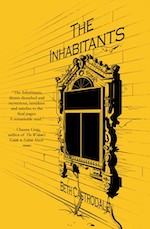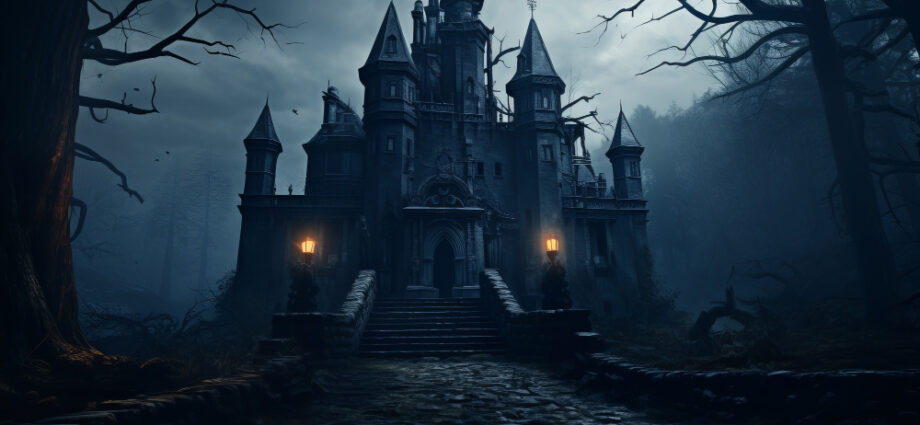Do you like scary stories? I read Beth’s new novel, The Inhabitants, and absolutely loved it. It draws you into a spooky and suspenseful atmosphere, and though you can feel the hairs standing up on the back of your neck, you enjoy the experience. It’s not graphic or overly violent, in case you wondered, but more moody and ethereal. Highly recommended! Plus she has some great tips for other writers interested in penning these types of stories below.
by Beth Castrodale
It’s sometime between midnight and 3 a.m., somewhere near 80 degrees, and my cousin Carolyn and I are too hot–and too terrified–to sleep. Though the porch we’re camped out on has turned into an oven, we’re up to our necks in our sweat-soaked sleeping bags, too afraid to expose more than our heads.
Why? The stories. The stories we’re making up as we go along, terrifying each other.
At a distance of decades, I can’t remember a single detail about any of those tales, only the fear they instilled in us–and the thrill-approaching-joy that accompanied that fear.
Looking back on this time–one of my clearest childhood memories, and one of the happiest–I’ve often wondered why, aside from the thrills, Carolyn and I scared each other into such a state. In recent years, some intriguing answers have emerged.
The Advantages of “Recreational Fear”
In an insightful article in the Washington Post, Richard Sima describes some of the benefits of recreational fear–the kind of scares we get from, say, frightening video games, books, or movies. According to a researcher Sima interviewed, Mathias Clasen, director of the wonderfully named Recreational Fear Lab at Aarhus University in Denmark, this kind of fear can be an “extremely important tool for learning.
We learn something about the dangers of the world. We learn something about our own responses: What does it feel like to be afraid? How much fear can I take?”
To Sima, Clasen described three types of scary-content fans: “adrenaline junkies,” who embrace the horror and get a mood boost from the adrenaline rush that accompanies it; “white knucklers,” who “lean out” of a frightening experience–enjoying it but finding a comfortable distance from it, perhaps through humor; and “dark copers,” who, as Sima observes, “seem to use scary media to help them deal with anxieties about the world or their own lives by focusing on a more concrete threat.”
Based on these descriptions, I think I’m somewhere between an adrenaline junkie and a white knuckler.
Scary Stories Help Us Learn to Regulate Our Emotions
Clasen and other researchers have indicated that recreational fear can help us learn to regulate our emotions when faced with frightening circumstances, which can help prepare us to cope with real-world threats. As reported by Melinda Wenner Moyer for the New York Times, a colleague of Clasen’s, Coltan Scrivner, uncovered an intriguing finding from interviews with people at the start of the Covid pandemic: “horror fans reported experiencing less pandemic-related psychological distress than non-fans.”
Although the reasons for this finding are unknown, one possibility is that recreational fear helped gird horror fans for the anxieties surrounding the pandemic.
Another colleague of Clasen’s, Marc Malmdorf Andersen, points to a “sweet spot” for recreational fear. In an article from Discover, Anderson observes:
“Too much fear results in a decrease in enjoyment, but also, too little fear results in a reduction in enjoyment. That [sweet spot] probably has to do with the prospects of learning about that situation and gaining insights into that situation.”
If “fear” and “recreation” are mutually exclusive terms for you, there’s likely little to be gained from a scare packaged as entertainment, and continuing to steer clear of such content is probably the best move. But if you’re an avid, or even occasional, consumer of horror, enjoy the thrills in good health. And if you’re thinking of writing horror, go ahead and create some thrills of your own.
Maximizing “Recreational Fear” When Writing Your Scary Stories
As I mentioned in the introduction, I can’t remember a single detail of the stories that my cousin and I scared each other with all those years ago. But as an avid reader, I’ve come to appreciate the elements of (and craft behind) truly spine-chilling stories and novels.
And while writing my first horror novel, The Inhabitants, I found some ways to ratchet up the tension and spookiness and to engage readers more generally. Here are the lessons I learned, in brief:
Tap into your own fears.
Like many people, one of my greatest fears is of the unknown, a feature of nearly every page of my novel (and of many other horror tales). From the beginning of the story, the protagonist, Nilda Ricci, is on unfamiliar ground: a shadowy old Victorian that she inherited from a great-aunt she never knew and that, at the beginning of the story, is a complete mystery.
The house was built by an eccentric architect whose constructions were said to influence the mind–supposedly, in beneficial ways. But Nilda never feels at ease there, and over time, as she learns more about the history of the place–and the people connected to it–those revelations are more unsettling than comforting.
If you’re contemplating writing a horror story but aren’t sure where to start, consider jotting down some things that make you fearful or uncomfortable. Then, pick one or two of them and let your imagination run with them.
For example, if cemeteries disturb you, what about a cemetery that the living can never depart from once they’ve passed through the gates? What alternate reality might exist in such a place? How would the most reluctant visitors cope, or try to? How might they interact with the dead, and with other living visitors? What conflicts or connections might arise?
Create a sense of mystery, of dark truths lurking in the shadows.
While writing The Inhabitants, I tried to bear in mind something that novelist Joanna Briscoe has observed:
“The power of a ghost story lies in what is feared beneath the surface of the narrative, terrors glimpsed or imagined in the cracks, rather than what leaps out of the shadows.”
I wanted The Inhabitants to be full of shadows, both literal and figurative, to keep my protagonist, Nilda, on edge. And I tried to be careful about how much light I’d cast into those shadows, and when. To my mind, revealing too much too early can kill the tension in a horror story.
Inhabit your haunted space.
When I write, the actions in my novels play out in my mind like scenes from a film, and I exist within the physical spaces of the scenes. This was especially true while I was writing The Inhabitants, in which the shadowy Victorian is a leading character of the story.
Putting myself in the rooms of the house helped me write clearer, more vivid descriptions of the setting, and it also helped me envision some of the house’s strange features–for example, a fireplace mantel carved with what appear to be faces of the dead.
Find points of empathy.
For anyone who writes horror, or is interested in doing so, I highly recommend Gabino Iglesias’s essay “What Writing Horror Can Teach All Writers.” In one especially striking passage of the essay, Iglesias says:
“Without empathy, horror fails. Readers need to feel a connection with the characters they’re reading about, and that connection can’t happen in an empathy vacuum.”
While writing The Inhabitants, I tried to show empathy for all of the characters, even for the biggest villain. In fact, it’s important for me to empathize with characters as I write any fictional work. If I can’t feel a connection with them, how will readers?
In your scary stories, keep things moving.
To honor the expectations of fans of horror and suspense, I tried to keep the plot of The Inhabitants moving at a brisk clip, especially during the last third of the novel. At the same time, when it came to the central mysteries of the story, I tried not to reveal too much too early, wanting readers to feel as on edge as the protagonist as she tries to make sense of these mysteries.
Balancing these goals came down to figuring out the pacing of the novel, which involved sketching out some storylines before drafting the relevant scenes. Although some writers steer clear of advance planning, I find rough outlines invaluable for working out story arcs for first drafts, and for helping me complete those drafts in a reasonable time frame.
Let your scary story surprise you.
Although I’m a fan of rough outlines, I never hew strictly to them. They’re just general guides, and once I get down to writing, stories and characters inevitably take on a life of their own. For me, this openness to possibilities is essential for writing truly chilling stories.
The ending of The Inhabitants was the product of just such openness, and it came to me as something of a surprise. Yet once I committed it to the page, I couldn’t imagine another closing for the book.
If you end up reading the novel, I hope you enjoy it, and if you’re thinking of writing your first horror tale, I hope my advice is helpful!
Note: Read more of Beth’s articles here on Writing and wellness!
Talk it Out: How Conducting Interviews Can Benefit Your Writing
How to Write Your Way Through Loss and Grief
Featured image by Freepik.
* * *
 Beth Castrodale worked as a newspaper reporter until her love of books led her to the publishing field. She was a senior editor at Bedford/St. Martin’s and is the founding editor of the book-review website Small Press Picks. Her début novel, Marion Hatley, was a finalist for a Nilsen Prize for a First Novel from Southeast Missouri State University Press, and an excerpt from her second novel, In This Ground, was a shortlist finalist for a William Faulkner – William Wisdom Creative Writing Award.
Beth Castrodale worked as a newspaper reporter until her love of books led her to the publishing field. She was a senior editor at Bedford/St. Martin’s and is the founding editor of the book-review website Small Press Picks. Her début novel, Marion Hatley, was a finalist for a Nilsen Prize for a First Novel from Southeast Missouri State University Press, and an excerpt from her second novel, In This Ground, was a shortlist finalist for a William Faulkner – William Wisdom Creative Writing Award.
In a review of Castrodale’s third novel, I Mean You No Harm, critic Bethanne Patrick observed, “Castrodale is the real thing, a novelist who fuses mordant humor and great genre tropes with warmth and courage.” An excerpt from her fourth novel, The Inhabitants, landed Castrodale an artist grant from the Mass Cultural Council. The novel was released by Regal House Publishing in September 2024.
For more information about Beth and her work, please see her website and connect with her on X (Twitter), Facebook, Goodreads, and LinkedIn.
The Inhabitants:
 Artist Nilda Ricci could use a stroke of luck. She seems to get it when she inherits a shadowy Victorian, built by an architect whose houses were said to influence the mind—supposedly, in beneficial ways.
Artist Nilda Ricci could use a stroke of luck. She seems to get it when she inherits a shadowy Victorian, built by an architect whose houses were said to influence the mind—supposedly, in beneficial ways.
At first, Nilda’s new home delivers, with the help of its longtime housekeeper. And Nilda falls for a handsome neighbor, a chemist whose herbal tonics boost her creativity.
But Nilda starts having strange experiences, making her wonder whether her house is haunted, or whether its architect’s intentions were less than benevolent. She also comes to suspect that her new love interest—and her housekeeper—aren’t quite what they seem.
“Take the classic Gothic element of a spooky old house, add a dash of modern #MeToo seasoning, and let everything simmer in the warmth of timeless maternal love, and you have Beth Castrodale’s deliciously clever new novel. The Inhabitants, dream-drenched and mysterious, tantalizes and satisfies to the final pages. A remarkable read.”
—Chauna Craig, author of The Widow’s Guide to Edible Mushrooms and Wings & Other Things
Find The Inhabitants at the following bookstores:

